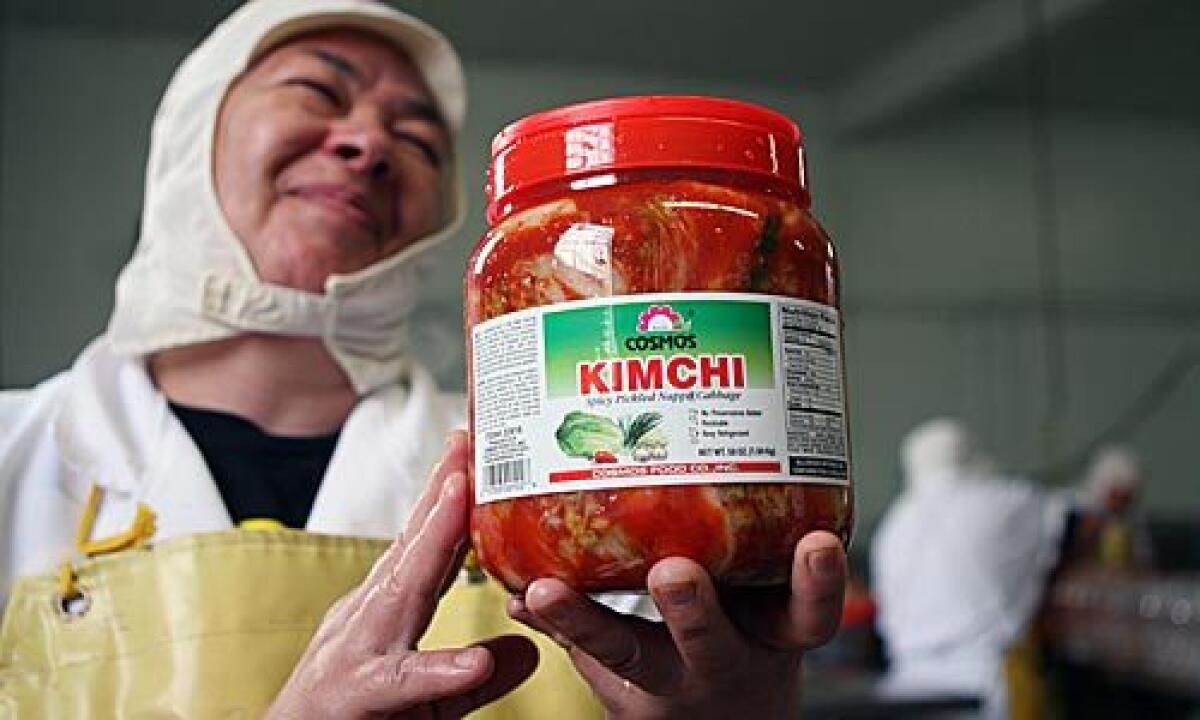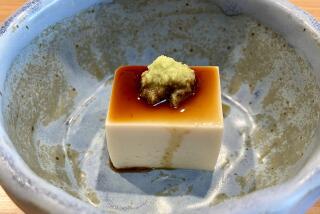Cosmos Food Co., fermenting revolution with its kimchi

- Share via
David Kim insists it tastes like his mom’s. He says despite machines that rumble as they chop and wash and mix and label, his factory-produced kimchi can compete with what appeared on the table after his mother spent hours laboring over wilted cabbage and anchovy-laden pepper paste on her kitchen floor in Seoul.
Of course, his mother doesn’t make kimchi anymore, now that her son owns Cosmos Food Co., which every day bottles 8,000 pounds of the spicy side dish that accompanies Korean meals.
For nearly 40 years, Cosmos -- named after the flower -- has been mass-producing kimchi at its 9,000-square-foot factory north of Elysian Park. The original owners were women who founded the business in 1971 and provided for a small Korean community that was slowly gaining a footing in Los Angeles. As three other owners came and went, Cosmos grew along with the Korean population.
Shortly after Kim bought the company in 2002, Cosmos’ business more than doubled, in part because it went mainstream: Its products now line the shelves of Costcos across California and Wal-Marts across America. And even in this economy, the market for Cosmos’ kimchi is likely to expand. Kimchi is, after all, a Korean staple, like milk and bread. Then there are the shoppers who’ve begun flocking to Costco and Wal-Mart to stretch their budgets and have discovered the red-covered pails that cost about $6.
“I got a call from Costco’s Southeast regional office, which handles Florida and Georgia, asking for pricing and a sample,” Kim says excitedly from inside his office, where the sharp smell of garlic permeates the air. The 49-year-old also just got back from a trip to the Midwest, where he discovered one of the company’s private labels (Cosmos also produces the brands Josan and Frieda’s) in a Wal-Mart in Hastings, Neb.
Kimchi-making was once a family affair in which grandmothers, mothers, daughters and aunts would gather for the arduous task of grinding together a peppery paste to be stuffed by hand between each layer in a head of cabbage. Centuries-old recipes have been proudly passed down through the generations.
“After marriage, sons used to live with their mothers, and kimchi-making was a woman’s job, where the [wife’s] mother-in-law was the head chef and her family recipe was used,” says Jayne Chang, director of the California Premier Culinary School, where she teaches Korean cooking.
When kimchi first appeared in stores decades ago, it was an expensive novelty. But today, with families spread out, buying the dozen or so ingredients needed for a small batch makes little sense when companies such as Cosmos sell inexpensive kimchi by the gallon.
“Korea is changing,” Kim says with a shrug as he walks through his compact factory, careful to avoid the pools of water that appear every few minutes as containers are rinsed and machines are hosed down.
“Young women don’t know how to make kimchi; they buy it. Normally, Korean women stayed home, but now a lot of them are working, and making kimchi takes too much time.”
Korean America has changed as well. While the first generation brought with it secret formulas for jars of pickled goodness, their American-raised children have, for the most part, been indifferent to learning how to make the dish. They rely on Mom and Korean markets that offer store-made versions by the pound, along with aisles of packaged brands.
Kim says Cosmos is the largest kimchi factory in the United States, an attribute acknowledged even by its main competitor, King’s Kimchi in San Francisco, which has been around since 1965.
Traditional kimchi can take weeks and even months to ferment, but Cosmos’ is ready in minutes.
The process begins with whole nappa cabbages that have been soaked overnight in giant metal tubs filled with a salt solution. A machine halves the cabbages, then employees swiftly carve out the cores and place the wedges on a conveyor belt. Brisk blades chop the leaves into bite-size pieces that are dropped into a churning water bath.
After three automated rinses to wash off the salt, a clean trough of cabbage is placed on a lift that rises and dumps into a tumbling bin that mixes the mass with crimson bowlfuls of red pepper paste -- a pungent brew made of dried anchovies, dried shrimp, ground sweet rice, water, sugar, onions, ginger and garlic. Lots of garlic.
If it weren’t for the last crucial step -- bottling the stuff -- Kim imagines he’d have far fewer than 30 employees. But human hands pack the kimchi into jars in a way machines simply haven’t perfected.
“You can’t put in too much because kimchi ferments and ripens and the bottle gets too much gas inside,” factory manager Teresa Guerrero advises as her rubber-gloved fingers pat a final layer into a plastic container.
Guerrero, 55, represents another shift in kimchi’s history. Born and raised in Guadalajara, Mexico, she has worked at Cosmos for almost 30 years and is responsible for taste-testing the product. The factory staff is, in fact, entirely made up of Latino immigrants who have learned to enjoy a dish that has no equal in their homelands.
“I don’t just know how to make tamales, beans and rice,” Guerrero says proudly. “I know how to make kimchi.”
Cosmos has clearly made fans of its employees. And its quick, cheap production means it has a long reach to a wide audience. Perhaps it’s kimchi’s turn to become ubiquitous in U.S. groceries, just as salsa has. And its future may lie in fusion food where the processed stuff is good enough when merged with other ingredients to create concoctions such as kimchi tacos and burgers.
But is something lost when a traditionally handmade food so essentially Korean that it even has a museum dedicated to it in Seoul is handed over to, gulp, machines?
“I don’t feel it’s any different from homemade,” insists Jin Seup Shim, vice president of Cosmos, who says his product tastes similar to what he grew up eating in the province of Chungcheong.
OK, but what about “Umeoni son mat,” that Korean saying loosely translated as “a mother’s touch makes it delicious”? If the treasured memories Shim has of his mother painstakingly seasoning cabbage leaves and pressing them into jars were instead replaced by recollections of canned kimchi, would there not be something lost from his childhood, from his Korean essence?
Shim mulls this over, then says, “If my mom didn’t make kimchi, maybe she would have had an easier life.”
More to Read
Eat your way across L.A.
Get our weekly Tasting Notes newsletter for reviews, news and more.
You may occasionally receive promotional content from the Los Angeles Times.











